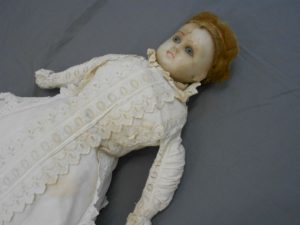
This wax doll was owned by Elizabeth Annie Robshaw.
It has a waxed head and legs with composition arms and hands. The cotton body has sawdust filling.
The doll is dressed in cotton lace fabric. There are three cotton petticoats. One of lace and pintucks and two plain petticoats. There are cotton drawers.
The doll has wax legs with moulded boots and composition arms. The thumb is missing on the left hand. The doll wears a ginger wig. There are holes in the ears for earrings, but the earrings are missing.
There are no markings on the doll.
The doll’s face and shoulder plate are badly damaged.
1870 – 1890
Elizabeth Annie Robshaw 1872 – 1955
Elizabeth was born 19 September 1872 at Mitchell Street Bendigo.
Her father John Robshaw was a printer and stationer in a shop on a site in Mitchell Street.
Elizabeth owned a Bookshop and Library in the Bendigo Arcade after her father’s business was sold in 1905.












